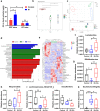Microbiota-derived I3A protects the intestine against radiation injury by activating AhR/IL-10/Wnt signaling and enhancing the abundance of probiotics
- PMID: 38706205
- PMCID: PMC11086037
- DOI: 10.1080/19490976.2024.2347722
Microbiota-derived I3A protects the intestine against radiation injury by activating AhR/IL-10/Wnt signaling and enhancing the abundance of probiotics
Abstract
The intestine is prone to radiation damage in patients undergoing radiotherapy for pelvic tumors. However, there are currently no effective drugs available for the prevention or treatment of radiation-induced enteropathy (RIE). In this study, we aimed at investigating the impact of indole-3-carboxaldehyde (I3A) derived from the intestinal microbiota on RIE. Intestinal organoids were isolated and cultivated for screening radioprotective tryptophan metabolites. A RIE model was established using 13 Gy whole-abdominal irradiation in male C57BL/6J mice. After oral administration of I3A, its radioprotective ability was assessed through the observation of survival rates, clinical scores, and pathological analysis. Intestinal stem cell survival and changes in the intestinal barrier were observed through immunofluorescence and immunohistochemistry. Subsequently, the radioprotective mechanisms of I3A was investigated through 16S rRNA and transcriptome sequencing, respectively. Finally, human colon cancer cells and organoids were cultured to assess the influence of I3A on tumor radiotherapy. I3A exhibited the most potent radioprotective effect on intestinal organoids. Oral administration of I3A treatment significantly increased the survival rate in irradiated mice, improved clinical and histological scores, mitigated mucosal damage, enhanced the proliferation and differentiation of Lgr5+ intestinal stem cells, and maintained intestinal barrier integrity. Furthermore, I3A enhanced the abundance of probiotics, and activated the AhR/IL-10/Wnt signaling pathway to promote intestinal epithelial proliferation. As a crucial tryptophan metabolite, I3A promotes intestinal epithelial cell proliferation through the AhR/IL-10/Wnt signaling pathway and upregulates the abundance of probiotics to treat RIE. Microbiota-derived I3A demonstrates potential clinical application value for the treatment of RIE.
Keywords: Radiotherapy; gastrointestinal tract toxicity; gut microbiota; indole-3-carboxaldehyde; intestinal stem cells; tryptophan metabolites.
Conflict of interest statement
No potential conflict of interest was reported by the author(s).
Figures








References
Publication types
MeSH terms
Substances
LinkOut - more resources
Full Text Sources
Research Materials
